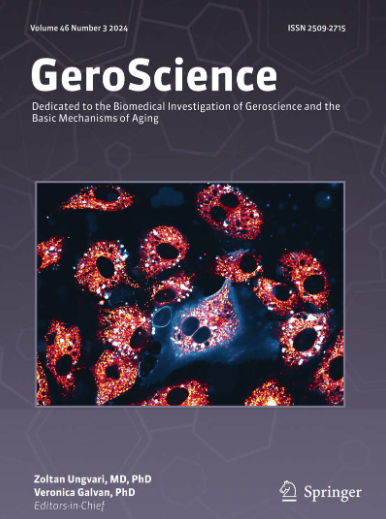他汀类药物与老年人步态速度储备的关系:伴随用药的影响。
IF 5.3
2区 医学
Q1 GERIATRICS & GERONTOLOGY
引用次数: 0
摘要
他汀类药物经常被开给老年人,但它们对衰老表型(如虚弱或生理储备)的影响仍知之甚少。步态速度储备(GSR),定义为最大步态速度和通常步态速度之间的差异,是生理储备的一个指标,反映了身体执行超出基线功能水平的能力。在这一人群中普遍存在的多重用药可能会导致他汀类药物与伴随药物之间的相互作用导致结果不一致。我们的目的是研究伴随用药如何缓和老年人他汀类药物使用与GSR之间的关联。为此,我们使用来自瑞士巴塞尔FELIX PLATTER大学老年医学系活动中心的数据进行了一项横断面观察队列研究(n = 5519名年龄≥60岁的成年人)。采用倾向评分加权的适度回归分析来评估联合用药对他汀类药物使用与GSR之间关系的影响。结果显示,与未使用他汀类药物相比,使用他汀类药物与较低的GSR相关(- 1.9 cm/s [95% CI, - 3.1至- 0.72])。然而,ACE抑制剂和阿司匹林显著影响这种关联。与非他汀类药物使用者相比,他汀类药物使用者的GSR差异增加了3.7 cm/s(从- 2.2到1.5 cm/s;95% CI, 0.0 - 7.4)和5.8 cm/s(从- 3.4到2.3 cm/s;95% CI, 2.5 - 9.1)。我们发现他汀类药物的使用与通常的步态速度(次要结果)之间没有统计学上的显著关联。综上所述,ACE抑制剂和阿司匹林与他汀类药物相互作用,将其与GSR的负相关逆转为正相关。未来的临床试验需要确定因果关系,并进一步调查他汀类药物同时使用对老年人群的影响。同时,我们的研究结果强调了在评估他汀类药物对老年人的影响时考虑伴随用药的重要性。本文章由计算机程序翻译,如有差异,请以英文原文为准。
The association between statins and gait speed reserve in older adults: effects of concomitant medication.
Statins are frequently prescribed to older adults, yet their effects on ageing phenotypes such as frailty or physiological reserves remain poorly understood. Gait Speed Reserve (GSR), defined as the difference between maximal and usual gait speeds, serves as an indicator of physiological reserve, reflecting the body's ability to perform beyond baseline functional levels. Polypharmacy, prevalent in this population, may contribute to inconsistent findings through interactions between statins and concomitant medications. We aimed to investigate how concomitant medications moderate the association between statin use and GSR in older adults. To this end, we conducted a cross-sectional observational cohort study using data from the Mobility Center at the University Department of Geriatric Medicine FELIX PLATTER, Basel, Switzerland (n = 5519 adults aged ≥ 60 years). Moderation regression analyses with propensity score weighting were used to evaluate the effect of concomitant medications on the association between statin use and GSR. Results showed statin use was associated with a lower GSR compared to non-use (- 1.9 cm/s [95% CI, - 3.1 to - 0.72]). However, ACE inhibitors and aspirin significantly influenced this association. The GSR difference for statin users compared to non-users increased by 3.7 cm/s (from - 2.2 to 1.5 cm/s; 95% CI, 0.0 to 7.4) with concomitant ACE inhibitor use and by 5.8 cm/s (from - 3.4 to 2.3 cm/s; 95% CI, 2.5 to 9.1) with aspirin use. We found no statistically significant association between statin use and usual gait speed, the secondary outcome. In conclusion, ACE inhibitors and aspirin interacted with statins, reversing the negative association with GSR into a positive one when co-used. Future clinical trials are needed to determine causality and further investigate the impact of concomitant medication use on statin effects in aging populations. Meanwhile, our findings underscore the importance of considering concomitant medication use when assessing the effects of statins in older adults.
求助全文
通过发布文献求助,成功后即可免费获取论文全文。
去求助
来源期刊

GeroScience
Medicine-Complementary and Alternative Medicine
CiteScore
10.50
自引率
5.40%
发文量
182
期刊介绍:
GeroScience is a bi-monthly, international, peer-reviewed journal that publishes articles related to research in the biology of aging and research on biomedical applications that impact aging. The scope of articles to be considered include evolutionary biology, biophysics, genetics, genomics, proteomics, molecular biology, cell biology, biochemistry, endocrinology, immunology, physiology, pharmacology, neuroscience, and psychology.
 求助内容:
求助内容: 应助结果提醒方式:
应助结果提醒方式:


